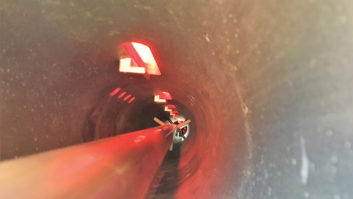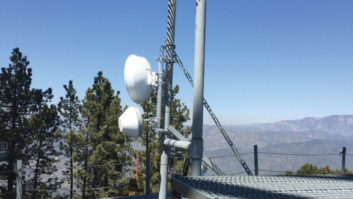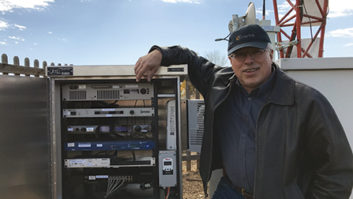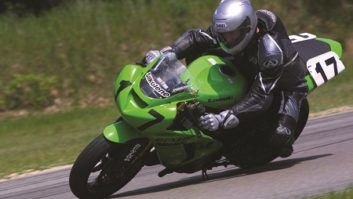As we described last time, the incentive auction was bound to have consequences for the FM stations on Los Angeles’ Mt. Wilson, because TV and radio share tower space there, often in close quarters. It soon became clear that this would be especially true in the vicinity of the “Post Office” site, where iHeartMedia has three of its four FMs, with the fourth next door. Historically, co-located users coped with the occasional work in the neighborhood by participating in group power reductions; but the changes now anticipated would probably require days upon days of work.
These articles explore the means by which iHeartMedia decided to operate its four Mt. Wilson FMs while the TV antenna changes are being made. We pick up the story as Deer Park has been selected for the temporary site.
Not long after the news about the Deer Park construction go-ahead came out, our SVPE, Tom Cox, let me know the basic framework of the project: what we wanted to achieve and how much the budget was. It was up to me to meet the goals within the budget framework.
One question that needed to be addressed was just how long we had to put all of this together. I did reach out to local TV engineers, but none really had finalized plans. The best I could get was, “We’ll be doing that over the summertime.” So … since summer officially starts on June 21, I decided that the end of May was a reasonable goal for the new site to be ready for use. Yes, somewhat random I will admit, but there was little else to go on.
Early in the project, we worked on deciding if we wanted to use two antennas fed from two separate two-channel star combiners, or alternatively, a single antenna with a four-channel combiner. Eventually, we decided to go with the single antenna. The reasons are quite simple really.
The transmitter room (see Fig. 1) seemed tailor-made for our needs. Note the in-place automatic transfer switch (ATS). Outside was its associated generator set. We did decide to replace the old air conditioner.

CBS TV used to maintain some satellite uplinks up at CBS Lane, and they had a special room built in “the house” to accommodate the control gear. Sometime earlier, all of it had been abandoned in place. In typical CBS fashion, it was all put together nicely, and seemed nearly custom-made for our needs. It already had an ATS and generator outside as well.
The contacts in the ATS are limited to 150 amps though, but considering the ERP and antenna gain we would have to work with (for the single eight-bay antenna), the amount of current needed by the transmitters was going to fit comfortably within that limit. If I had opted for lower antenna gain, I would have needed more transmitter power, which would have necessitated an upgrade to the electrical system. For this reason, we decided to go with the eight-bay antenna.
THE TOWER ISN’T STRONG ENOUGH!
Once we had the antenna picked (an eight-bay, half-wave spaced ERI Axiom), we went back to the landlord, American Tower Corp., and let them do the structural analysis. Unfortunately, the results were not good: The tower as it stood was not strong enough to hold up our chosen antenna.
However, ATC has all the resources at hand to study the issue and to come up with the fixes needed. In addition, since we had picked ERI already, the two engineering teams worked together to come up with the pole needed to hold up this rather large antenna, and more specifically, the modifications needed to the tower to make it work for the application. The pole, the tower modifications and installation of both were on ATC’s dime. The only real question was whether or not that part would get done on time.

CHOOSING THE COMBINER AND TRANSMITTERS
Three manufacturers were all asked for bids on the antenna and combiner. Naturally, I had to consider pricing, but with the upcoming repack work, I also had to consider how long the various companies would take to deliver the antenna and/or combiner.
In the end, I ended up choosing Shively for the combiner and, as noted above, ERI for the antenna. Both had good combinations of pricing and delivery time.
The transmitter choice was pretty easy for me, since we already had two Nautel GV-series transmitters in place and on the air (for KOST and KYSR). Clearly, Nautel isn’t the only brand that can do what it does; however, it’s easier from an ongoing maintenance perspective to have the same transmitters across our stations — from spares to software updates to staff knowledge.
Working backwards (from the antenna down) and starting with the ERP we were looking at for on each station, I chose two GV10s, a GV5 and a VS2.5 with the VS-HD. Yes, we were adding HD to all the stations as well. The footprints of these transmitters would also be easily accommodated with the space in the old CBS satellite room, along with three racks.
THE STL SYSTEM
Our stations on Mt. Wilson each have three STLs to choose from (not including our VSAT system), and it was my intention to have all three of them also available at Deer Park.
Additionally, we have transmitter site versions of our automation system in place, the idea being that they are ready to play out audio in the event we have a system meltdown in Burbank, and I wanted that audio to be available at Deer Park as well. The reality is that I wanted to “copy” whatever I was doing up on Video Road, and to “paste” it down at Deer Park.
At last year’s Radio Show, I was introduced to the newest member of GatesAir’s IP link family, the IP MPXp. By simply sampling the composite outputs of our current set of audio processors, with their custom settings and particular on-air qualities, we could literally do the copy and paste I was after. By using the MPXp:
• We would have access to our main and backup audio processors, each of which is driven by the output of a 4X1 AES selector, thus …
• Giving us access to all three STLs down at Deer Park …
• And making sure the Deer Park transmitters sound identical to the Video Road transmitters.
• By adding RDS to the appropriate inputs on the audio processors, we have access to it as well at Deer Park.
So as you can see, there was no need to buy additional audio processors or RDS generators. The MPXp units are configured to use a 132 kHz sample rate, thus giving them an audio bandwidth of 60 kHz — more than enough to include all the stereo information and RDS.
CONNECTING THE SITES
Since Deer Park is 0.6 miles west of the main sites at Video Road, we clearly needed some way of making them communicate. I opted for a licensed radio solution; however, the time to implement such a system ended up being more than we had to work with. For that reason, we opted to install a parallel unlicensed 5.8 GHz radio link between the buildings as well.
Three of our four stations are in the Post Office building on Video Road; however, KBIG is next door in the Poole building. We had no fast communications between the buildings (though they are on the same AT&T switched Ethernet circuit, thus providing 10 mbps of connectivity between the two).
Since we had the IP MPXp to pass information from the Poole building to Deer Park, it was clear we needed to connect the Poole building to the Post Office before anything else. We ended up doing that with yet another unlicensed radio, this time at 60 GHz. It was an experiment that worked out well enough for us to keep it going. To be fair, this radio includes yet another 5.8 GHz radio, embedded, so that it can keep passing data even if the 60 GHz portion fades or fails.
Next time: We start putting it all together.
Doug Irwin, CPBE AMD DRB, is vice president of engineering at iHeartMedia in Los Angeles and a technical advisor to Radio World.
Comment on this or any story. Write to [email protected].












